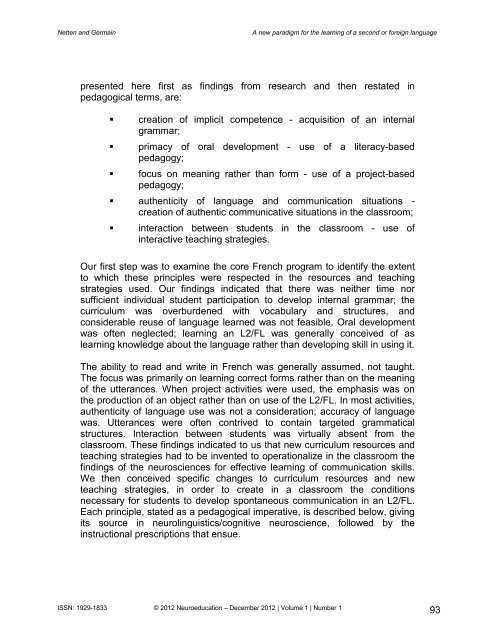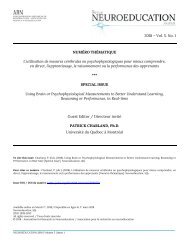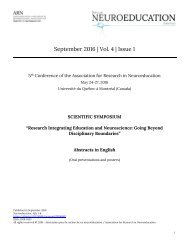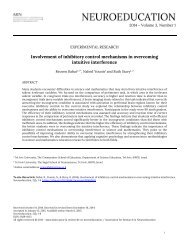Neuroeducation_2012_vol-1_no-1_full
Neuroeducation journal - Volume 1, Issue 1 (2012) - 144 pages
Neuroeducation journal - Volume 1, Issue 1 (2012) - 144 pages
Create successful ePaper yourself
Turn your PDF publications into a flip-book with our unique Google optimized e-Paper software.
Netten and Germain<br />
A new paradigm for the learning of a second or foreign language<br />
presented here first as findings from research and then restated in<br />
pedagogical terms, are:<br />
• creation of implicit competence - acquisition of an internal<br />
grammar;<br />
• primacy of oral development - use of a literacy-based<br />
pedagogy;<br />
• focus on meaning rather than form - use of a project-based<br />
pedagogy;<br />
• authenticity of language and communication situations -<br />
creation of authentic communicative situations in the classroom;<br />
• interaction between students in the classroom - use of<br />
interactive teaching strategies.<br />
Our first step was to examine the core French program to identify the extent<br />
to which these principles were respected in the resources and teaching<br />
strategies used. Our findings indicated that there was neither time <strong>no</strong>r<br />
sufficient individual student participation to develop internal grammar; the<br />
curriculum was overburdened with vocabulary and structures, and<br />
considerable reuse of language learned was <strong>no</strong>t feasible. Oral development<br />
was often neglected; learning an L2/FL was generally conceived of as<br />
learning k<strong>no</strong>wledge about the language rather than developing skill in using it.<br />
The ability to read and write in French was generally assumed, <strong>no</strong>t taught.<br />
The focus was primarily on learning correct forms rather than on the meaning<br />
of the utterances. When project activities were used, the emphasis was on<br />
the production of an object rather than on use of the L2/FL. In most activities,<br />
authenticity of language use was <strong>no</strong>t a consideration; accuracy of language<br />
was. Utterances were often contrived to contain targeted grammatical<br />
structures. Interaction between students was virtually absent from the<br />
classroom. These findings indicated to us that new curriculum resources and<br />
teaching strategies had to be invented to operationalize in the classroom the<br />
findings of the neurosciences for effective learning of communication skills.<br />
We then conceived specific changes to curriculum resources and new<br />
teaching strategies, in order to create in a classroom the conditions<br />
necessary for students to develop spontaneous communication in an L2/FL.<br />
Each principle, stated as a pedagogical imperative, is described below, giving<br />
its source in neurolinguistics/cognitive neuroscience, followed by the<br />
instructional prescriptions that ensue.<br />
ISSN: 1929-1833 © <strong>2012</strong> <strong>Neuroeducation</strong> – December <strong>2012</strong> | Volume 1 | Number 1<br />
93








